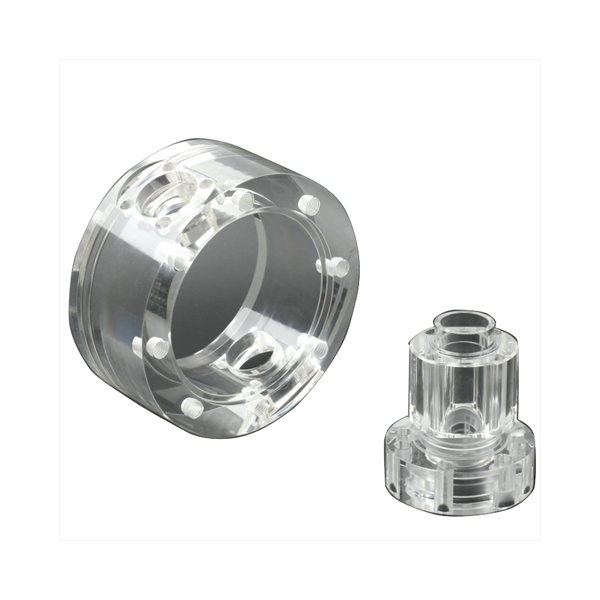GD Prototyping

Vapor Polishing
-
Suitable Materials: Polycarbonate (PC), acrylic (PMMA), polysulfone, Ultem, and other engineering plastics
-
Surface Finish: Optical-grade transparency with reduced haze
-
Accuracy: Maintains tight dimensional tolerances
-
Part Size Range: Small precision parts to medium-sized housings
-
Compatibility: Works on CNC machined plastics, 3D printed parts, and molded components
- Description
- Specification
- Application
- FAQS
Vapor Polishing is a surface finishing method used to enhance the clarity and smoothness of plastic parts. When plastic components undergo machining, even with high precision, they often retain fine tool marks or a matte appearance. Vapor polishing provides a way to refine the surface and restore transparency, especially in parts made from materials like acrylic or polycarbonate.
This process involves placing the part in a chamber where it is exposed to a controlled chemical vapor. The vapor briefly softens the outermost surface of the plastic, allowing it to reflow at the microscopic level. As the material settles, the surface becomes smoother and more transparent. You can often achieve a clear, glossy finish that is closer to the material's original, pre-machined appearance.
Vapor Polishing is particularly useful when working with parts that require high optical clarity or smooth finishes without physical abrasion. You might apply this technique to items such as light pipes, lenses, display windows, or medical housings—anywhere surface quality contributes to performance or appearance.
You can incorporate vapor polishing after CNC machining, 3D printing, or other subtractive processes to remove surface haze or texture. It works best with specific thermoplastics that respond predictably to the vapor treatment. Not all plastics are compatible, so material selection is a key factor during planning.
This method also supports complex geometries. Because the vapor reaches internal surfaces that are difficult to polish mechanically, you can finish detailed or enclosed parts more efficiently. It eliminates the need for manual polishing, which may be time-consuming or impractical for intricate shapes.
By including vapor polishing in your finishing process, you gain a way to improve surface clarity, reduce visual defects, and enhance part aesthetics without altering the part’s dimensions. If you're aiming for a refined, transparent finish on plastic parts, this technique offers a consistent and effective solution.
| Parameter | Value / Description |
|---|---|
| Material Compatibility | Primarily used for plastics such as ABS, PMMA (acrylic), polycarbonate, and polyamide |
| Polishing Method | Vapor polishing uses chemical vapors (typically solvent-based) to smooth the surface of plastic parts |
| Surface Finish | Smooth, glossy, and transparent finish, often better than traditional mechanical polishing |
| Solvents Used | Acetone, methyl ethyl ketone (MEK), isopropyl alcohol, and other plastic-compatible solvents |
- Prototyping & Product Development:Ideal for producing high-quality, transparent plastic prototypes with a smooth, glossy finish for design validation and client presentations.
- Medical Devices:Used for clear plastic components like medical housings, test tubes, and surgical tools that require a polished, non-porous surface.
- Consumer Electronics:Enhances the appearance of clear or translucent parts such as smartphone cases, display screens, and housings, improving both aesthetics and durability.
- Automotive Components:Used for small cosmetic parts, headlight covers, interior components, and clear lenses that need a smooth, polished finish.
- Aerospace & Defense:Applicable to transparent and lightweight plastic parts used in avionics and instrument displays, ensuring clarity and smoothness.
- Cosmetic and Display Products:Polishing display models, custom parts, or clear containers to achieve a high-gloss finish, enhancing product appearance.
- Architectural Models:Provides clear, polished finishes for small-scale models, architectural prototypes, and presentation pieces.
- Clear Plastic Components:Used to polish parts like acrylic signs, lenses, light covers, and transparent parts requiring high optical clarity.
1. What is vapor polishing?
Vapor polishing is a process where plastic parts are exposed to solvent vapors, which smooth and enhance the surface to create a glossy, transparent finish.
2. What materials can be vapor polished?
Primarily used for plastics like ABS, acrylic (PMMA), polycarbonate, and polyamide (nylon).
3. How long does the vapor polishing process take?
The process typically takes 5–30 seconds, depending on the size of the part and material being polished.
4. Does vapor polishing affect part dimensions?
The process removes a minimal amount of material (typically 0.1–0.5 mm) and typically maintains the part’s original dimensions.
5. What solvents are used for vapor polishing?
Common solvents include acetone, methyl ethyl ketone (MEK), and isopropyl alcohol, chosen based on the material being polished.










